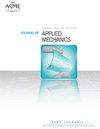Non-quadratic strain gradient plasticity theory and size effects in constrained shear
IF 2.8
4区 工程技术
Q2 MECHANICS
引用次数: 1
Abstract
A previously proposed strain gradient plasticity theory is extended to incorporate a non-quadratic power law function of the plastic strain gradient in the free energy expression with an exponent of N + 1. The values of N are taken to vary from N = 1 to N = 0. A simple shear problem of a metal layer between rigid boundaries is analyzed. Two stages of plastic deformation are considered. In stage I, the plastic strain is taken to be zero at the boundaries. Stage I ends when a specified magnitude of the plastic strain gradient is attained at the boundaries. In stage II, the magnitude of the plastic strain gradient at the boundaries is fixed at the specified value. With N = 0, a critical plastic strain gradient cannot be specified at the boundaries because the plastic strain gradient is infinite at the boundaries. The theory with N = 0 predicts a constant plateau stress immediately after initial yield, and the dependence of the plateau stress on the layer thickness can fit experimentally observed plateau stress values. However, with N = 0, a stress gap occurs between the initial yield stress and the plateau stress. The theory with 0 < N = 1 and with stage II also can reproduce the experimentally observed dependence of the plateau stress on the layer thickness for any value of N in that range, with an appropriate value of critical plastic strain gradient at the boundaries. The solution for 0 < N = 1 includes that for N = 0 as a limiting case.约束剪切中的非二次应变梯度塑性理论及尺寸效应
将先前提出的应变梯度塑性理论扩展为在指数为N+1的自由能表达式中包含塑性应变梯度的非二次幂律函数。N的值在N=1到N=0之间变化。分析了刚性边界之间金属层的一个简单剪切问题。考虑了塑性变形的两个阶段。在阶段I中,将边界处的塑性应变取为零。当在边界处获得指定大小的塑性应变梯度时,阶段I结束。在第二阶段,边界处的塑性应变梯度的大小固定在指定值。当N=0时,不能在边界处指定临界塑性应变梯度,因为塑性应变斜率在边界处是无限的。N=0的理论预测在初始屈服后立即出现恒定的平台应力,并且平台应力对层厚度的依赖性可以拟合实验观察到的平台应力值。然而,当N=0时,在初始屈服应力和平台应力之间出现应力间隙。对于该范围内的任何N值,0<N=1和阶段II的理论也可以再现实验观察到的平台应力对层厚度的依赖性,在边界处具有适当的临界塑性应变梯度值。0
本文章由计算机程序翻译,如有差异,请以英文原文为准。
求助全文
约1分钟内获得全文
求助全文
来源期刊
CiteScore
4.80
自引率
3.80%
发文量
95
审稿时长
5.8 months
期刊介绍:
All areas of theoretical and applied mechanics including, but not limited to: Aerodynamics; Aeroelasticity; Biomechanics; Boundary layers; Composite materials; Computational mechanics; Constitutive modeling of materials; Dynamics; Elasticity; Experimental mechanics; Flow and fracture; Heat transport in fluid flows; Hydraulics; Impact; Internal flow; Mechanical properties of materials; Mechanics of shocks; Micromechanics; Nanomechanics; Plasticity; Stress analysis; Structures; Thermodynamics of materials and in flowing fluids; Thermo-mechanics; Turbulence; Vibration; Wave propagation
联系我们:info@booksci.cn
Book学术提供免费学术资源搜索服务,方便国内外学者检索中英文文献。致力于提供最便捷和优质的服务体验。
Copyright © 2023 布克学术 All rights reserved.
京ICP备2023020795号-1
 京公网安备 11010802042870号
京公网安备 11010802042870号
京ICP备2023020795号-1

Book学术文献互助群
群 号:604180095


 求助内容:
求助内容: 应助结果提醒方式:
应助结果提醒方式:
